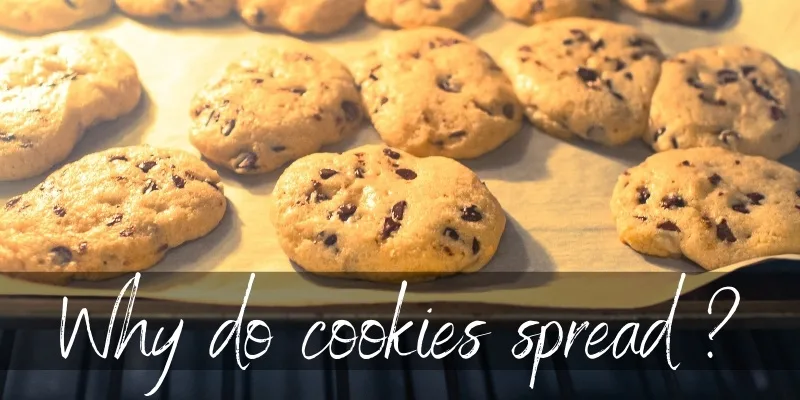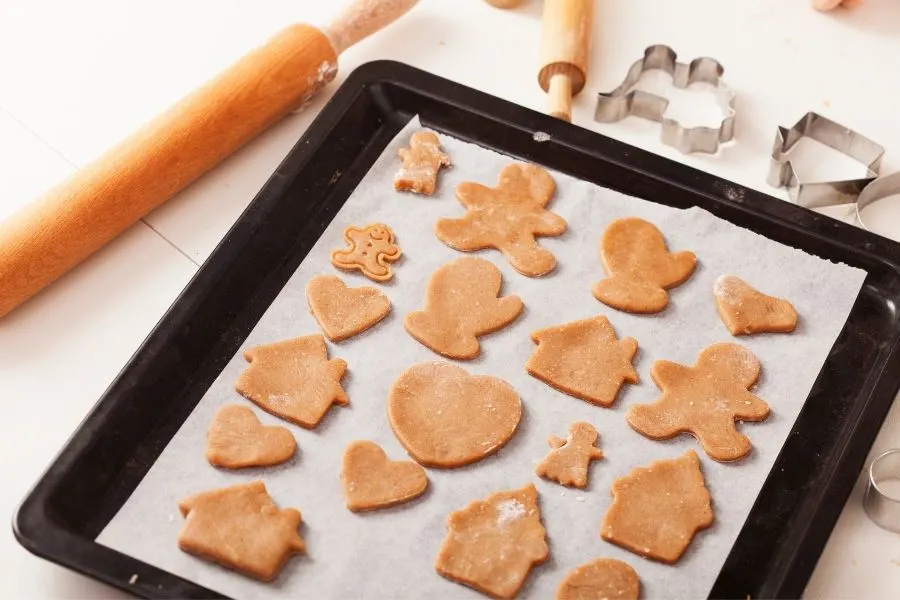Cookies are a popular sweet treat, and they’re highly customizable. Each family has their favorite recipe, and each person likes their cookie a different way. One thing always baffles those who are new to baking cookies: how much they spread. You work on a great cookie dough, place your cookie balls on a baking sheet, cramming as many as you can, and then end up with a flat, messy big cookie.
Why do cookies spread ? And how can you estimate how much they will spread ? How do you get cookies the texture you want them to be ? And finally, how do you even know when cookies are done ? All this and more, coming right up !

Cookies spread in the oven because they have a large amount of butter in them. The butter melts at high heat, and unless you’ve added a lot of flour, the entire cookie will flatten. How much each cookie flattens depends on how much flour you’ve added, how much butter there is, and what other ingredients there are.
Cookies high in fat will spread the most. Those very low on fat will spread the least, but may end up tasting a bit dry. The ratio between flour, butter, and sugar is what really gives cookies their texture and signature chewy vs crispy feel.
For example, if you want your cookies to be crispy, you add more sugar than flour and butter. If you want them soft and chewy, you add more butter and flour than sugar.
When baking your cookies, you’re bound to make some mistakes. Don’t take them to heart, the best cookies come with experience, and when you don’t stress that much about how they turn out.
So with your cookies, there are a few general guidelines to follow. of course, you can just ignore them. But these are simply ways to make sure you’ve done the most you can to get perfect cookies.
Read also: Can You Freeze Tiramisu ?
Always use a cool baking tray
Whenever you’re baking cookies you likely have a large batch of cookie dough waiting. That’s all fine and dandy but your oven is only to large. So, you have to bake in turns, perhaps using the same baking tray. We recommend getting a spare, and using a cool one each time, even if you’re only cooking a single tray at a time.
The reasoning behind this is that your cookies won’t hit a still-hot baking tray, so they won’t spread immediately and will be easier to work with.
Do not grease the parchment paper
Whether you’re using silpat or parchment paper, there’s a way to stop your cookies from spreading too much. You simply need to not grease the parchment or silpat, because the cookies will unstick very easily. And if you grease them, you risk them sliding around when you take them out the oven.

You may be tempted to cram as many cookies as you can, without remembering that these things spread in the oven. Give them two whole inches space between each other. Otherwise you’ll get one giant melted cookie, though some may like that.
To make sure you get evenly sized cookies, you should use a tool to portion each and every piece. It could be a small ladle, a teaspoon, or even an ice cream scoop. As long as you get all the cookies to an even size, you can bake them at the same time without burns edges/
If you make each cookie by hand, you need a lot of practice to know how much you should add. For example larger cookies will spread out more, since there is more dough. So, you need to leave them more space than others.
There are two ways to keep cookies from spreading, and they’re very different from one another. The fist requires your dough to have a lot of flour, so the butter will absorb all of it. Otherwise it will easily spread. With this method you will end up with a softer, chewy cookie rather than a crispy one.
Another method is to use muffin trays, and fill each of the holes with cookie dough. You need to be careful with this method, since you’re restricting the space the cookies have. So be sure the bake these on a low heat. Otherwise you risk a burnt exterior with an undercooked, still-raw interior.
No matter how you look at it, cookies will eventually spread. The dough becomes looser, because the butter holding everything together will melt. You can either try and contain the dough in a certain area or slow down the spread by adding more flour.
Read Also: Can You Reheat Pizza Rolls?
You cookies are done when they’ve developed a nice, golden edge and the middle part is no longer shiny. Once the edges are beginning to darken, like a light brown, the cookies are starting to burn.
Keep in mind that round is the best shape to bake anything, cookies included. Otherwise the edges (like stars or rectangles) will be much crispier than the middle.
Another important note is to make your cookies a medium size. Too large and they will spread out the size of your palm. By the time the middle is cooked through, the edges are burnt. Too small and you will easily burn them, because almost any heat setting will be too much.
A good size for cookies (raw) is an inch-thick ball. These usually spread to about two inches in diameter, and they bake evenly.
And that’s pretty much it about cookies, and why they spread. No matter how you make your cookie dough, it will eventually spread, more or less. The more butter (or the less flour), the more the dough will spread. But don’t try to use too much flour, otherwise your cookies will be too thick in the middle and remain raw.
A little spread is good, just make sure to leave at least 2 inches between the cookie balls before you pop them in the oven.

